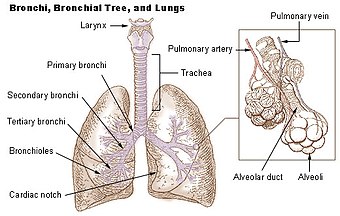Bronchiole
This article includes a list of general references, but it lacks sufficient corresponding inline citations. (May 2015) |
| Bronchiole | |
|---|---|
 Diagram of the alveoli with both cross-section and external view. | |
| Details | |
| System | Respiratory system |
| Identifiers | |
| MeSH | D055745 |
| TA98 | A06.5.02.026 |
| TA2 | 3282 |
| TH | H3.05.02.0.00005 |
| FMA | 7410 |
| Anatomical terminology | |
The bronchioles or bronchioli (pronounced bron-kee-oh-lee) are the smaller branches of the
Structure

The
The diameter of the bronchioles plays an important role in air flow. The bronchioles change diameter to either increase or reduce air flow. An increase in diameter is called
Bronchioles

The
Terminal bronchioles
The terminal bronchioles are the most distal segment of the conducting zone. They branch off the lesser bronchioles. Each of the terminal bronchioles divides to form respiratory bronchioles which contain a small number of alveoli. Terminal bronchioles are lined with simple ciliated cuboidal epithelium containing club cells. Club cells are non-ciliated, rounded protein-secreting cells. Their secretions are a non-sticky, proteinaceous compound to maintain the airway in the smallest bronchioles. The secretion, called pulmonary surfactant, reduces surface tension, allowing for bronchioles to expand during inspiration and keeping the bronchioles from collapsing during expiration. Club cells are a stem cell of the respiratory system, and also produce enzymes that detoxify substances dissolved in the respiratory fluid.
Respiratory bronchioles
The respiratory bronchioles are the narrowest airways of the lungs, 0.5 mm across.
Clinical significance
Diseases of the bronchioles include asthma, bronchiolitis obliterans, respiratory syncytial virus infections, and influenza.
Inflammation
The medical condition of inflammation of the bronchioles is termed bronchiolitis.[7]
Additional images
-
Cross sectional cut of primary bronchiole
-
- Alveolar duct
- Alveolus
References
- ^ ISBN 9780470233474.
- PMID 26694039.
- ISBN 9780071222075.
- ISBN 978-0-911910-87-2.
- ISBN 978-0-321-49804-5.
- ^ Paxton, Steve; Peckham, Michelle; Knibbs, Adele (2003). "Respiratory: Trachea, bronchioles and bronchi". University of Leeds.
- PMID 25414585.
Further reading
- Saladin, Kenneth S. Anatomy & Physiology: the Unity of Form and Function. New York, NY: McGraw-Hill, 2007.
- Dudek, Ronald W. High-Yield Histology, 3rd ed. (2004). ISBN 0-7817-4763-5
- Gartner, Leslie P. and James L. Hiatt. Color Atlas of Histology, 3rd ed. (2000). ISBN 0-7817-3509-2
- Gartner, Leslie P. and James L. Hiatt. Color Textbook of Histology (2001). ISBN 0-7216-8806-3
External links
- Histology image: 13606loa – Histology Learning System at Boston University
- Histology image: 13607loa – Histology Learning System at Boston University
- Diagram at davidson.edu
- Histology at umdnj.edu


